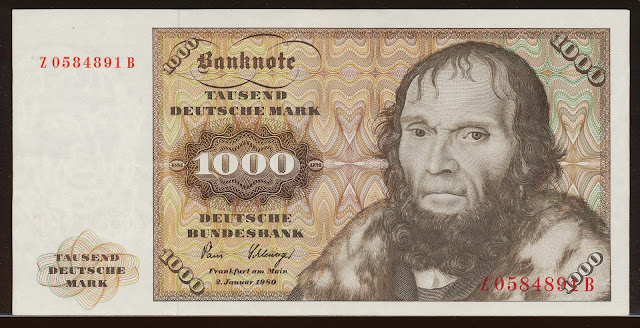German banknotes 1000 DM Deutsche Mark banknote 1980, issued by the Deutsche Bundesbank - German Federal Bank
1000 Deutsche Mark old German pre-euro bank note.
German banknotes, German mark banknotes, Deutsche Mark, German paper money, German bank notes, Germany banknotes, Germany paper money, Germany bank notes, German currency, German East African banknotes, German Rentenmark.Obverse: Portrait of Magdeburg Theologians Dr. Johannes Schöner by Lucas Cranach the Elder (1529), Royal Museums of Fine Arts Brussels, Belgium.
Reverse: The Limburg Cathedral symbolizes Romanesque art of construction in Germany.
Germany banknotes - Germany paper money
Deutsche Bundesbank - German Federal Bank
1960-1980 issue
The third series of German mark banknotes was introduced in 1960 by the Bundesbank, depicting neutral symbols, paintings by the German painter Albrecht Dürer, and buildings. There were 5 Deutsche Mark, 10 Deutsche Mark, 20 Deutsche Mark, 50 Deutsche Mark, 100 Deutsche Mark, 500 Deutsche Mark and 1000 Mark denominations.
5 Deutsche Mark 10 Deutsche Mark 20 Deutsche Mark 50 Deutsche Mark
100 Deutsche Mark 500 Deutsche Mark 1000 Deutsche Mark
100 Deutsche Mark 500 Deutsche Mark 1000 Deutsche Mark
Johannes Schöner
Johannes Schöner (January 16, 1477 in Karlstadt am Main – January 16, 1547 in Nürnberg) (aka, Johann Schönner, Johann Schoener, Jean Schönner, Joan Schoenerus) was a renowned and respected German polymath. It is best to refer to him using the usual 16th-century Latin term "mathematicus", as the areas of study to which he devoted his life were very different from those now considered to be the domain of the mathematician. He was a priest, astronomer, astrologer, geographer, cosmographer, cartographer, mathematician, globe and scientific instrument maker and editor and publisher of scientific tests. In his own time he enjoyed a European wide reputation as an innovative and influential globe maker and cosmographer and as one of the continents leading and most authoritative astrologers. Today he is remembered as an influential pioneer in the history of globe making and as a man who played a significant role in the events that led up to the publishing of Copernicus' "De revolutionibus" in Nürnberg in 1543.
Limburg Cathedral - Limburger Dom
The Catholic Cathedral of Limburg, also known as Georgsdom or Limburger Dom in German after its dedication to Saint George, is located above the old town of Limburg in Hesse, Germany. It is the cathedral of the Roman Catholic Diocese of Limburg. Its high location on a rock above the Lahn provides its visibility from far away. The building is one of the most perfect buildings of the late Romanesque style.

